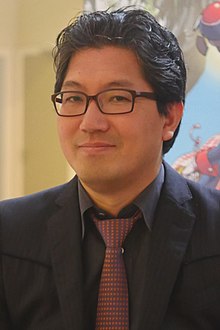Portal:Video games
The Video Games Portal

A video game or computer game is an electronic game that involves interaction with a user interface or input device (such as a joystick, controller, keyboard, or motion sensing device) to generate visual feedback from a display device, most commonly shown in a video format on a television set, computer monitor, flat-panel display or touchscreen on handheld devices, or a virtual reality headset. Most modern video games are audiovisual, with audio complement delivered through speakers or headphones, and sometimes also with other types of sensory feedback (e.g., haptic technology that provides tactile sensations). Some video games also allow microphone and webcam inputs for in-game chatting and livestreaming.
Video games are typically categorized according to their hardware platform, which traditionally includes arcade video games, console games, and computer games (which includes LAN games, online games, and browser games). More recently, the video game industry has expanded onto mobile gaming through mobile devices (such as smartphones and tablet computers), virtual and augmented reality systems, and remote cloud gaming. Video games are also classified into a wide range of genres based on their style of gameplay and target audience. (Full article...)
Featured articles –
Designer Tomohiro Nishikado drew inspiration from video games such as Gun Fight (1975) and Breakout (1976), electro-mechanical target shooting games, and science fiction narratives such as the novel The War of the Worlds (1897), the anime Space Battleship Yamato (1974), and the film Star Wars (1977). To complete development, he had to design custom hardware and development tools. Upon release, Space Invaders was an immediate commercial success; by 1982, it had grossed $3.8 billion ($14 billion in 2023-adjusted terms), with a net profit of $450 million ($1.7 billion in 2023 terms). This made it the best-selling video game and highest-grossing entertainment product at the time, and the highest-grossing video game of all time.
Space Invaders is considered one of the most influential and greatest video games of all time, having ushered in the golden age of arcade video games. It was the inspiration for numerous video games and game designers across different genres, and has been ported and re-released in various forms. The 1980 Atari VCS version quadrupled sales of the Atari VCS, thereby becoming the first killer app for video game consoles. More broadly, the pixelated enemy alien has become a pop culture icon, often representing video games as a whole. (Full article...)
Unlike many of its contemporary real-time strategy games, Sacrifice places little emphasis on resource gathering and management. There is no system of workers; the players' wizards collect souls to summon creatures, and their mana—energy for casting spells—constantly regenerates. Players customize their attacks by choosing from spells and creatures aligned to five gods. To defeat an opponent, the player's wizard sacrifices a friendly unit at the opposing wizard's altar, thereby desecrating it and banishing the enemy wizard. Aside from a single-player campaign, Sacrifice offers a multiplayer mode, in which up to four players can play against each other over computer networks.
Sacrifice was created by a small team of developers; most of the work was done by four key personnel. The graphic engine of the game uses tesselation: thousands of polygons are used to display an object and as lesser details are needed, the number of polygons is reduced. By adjusting the required level of detail, Sacrifice can be run on various machines with the highest possible quality of graphics. Complementing the graphics of the game were the voice work of professional actors, such as Tim Curry, and the musical compositions of Kevin Manthei. Sacrifice was praised by reviewers for the novel designs of its creatures and for its humorous content. The high level of attention needed to manage its frenetic combat was mentioned as a flaw. Despite winning several awards, Sacrifice was not a commercial success. (Full article...)
Terra Nova has been cited as one of the first squad-oriented games with three-dimensional (3D) graphics; the player is often assisted by artificially intelligent teammates who may be given tactical commands. Conceived by Looking Glass after the completion of their first game, Ultima Underworld: The Stygian Abyss, Terra Nova was subject to a long and difficult development process, caused in part by the production of its full-motion video cutscenes. The game's TED engine can render 3D outdoor environments and simulate physics; the latter enables such effects as procedural animation.
Terra Nova's critical reception was highly positive. Reviewers praised its tactical elements, and several compared it to the 1995 video game MechWarrior 2: 31st Century Combat. However, reception of its graphics was mixed, and many noted the game's steep system requirements. Despite critical acclaim and sales in excess of 100,000 units, the game was a commercial failure: it did not recoup its development costs. While it was intended to be the first in a series, its low sales led the company to cancel plans for a sequel. (Full article...)
The gameplay is similar to that of the previous installments, and focuses on combo-based combat, achieved through the player's main weapon—the Blades of Athena—and a secondary weapon acquired later in the game. It features quick time events that require the player to complete various game controller actions in a timed sequence to defeat stronger enemies and bosses. Up to three magical attacks and a power-enhancing ability can be used as alternative combat options. Ghost of Sparta also features puzzles and platforming elements. The combat system was updated with 25 percent more gameplay than its PSP predecessor, God of War: Chains of Olympus.
Ghost of Sparta received positive reviews from critics for its story, scope, and graphical illustration, though criticism was given for the general lack of gameplay innovation from its predecessor, Chains of Olympus. Several critics consider it to be the best-looking game on the PSP. Others have compared the overall game to those on the PlayStation 3 (PS3), and some have said that the graphics are better than those of the PlayStation 2 (PS2). Ghost of Sparta received several awards, including "Best Handheld Game", "Best PSP Game", and "PSP Game of Show" at the 2010 Electronic Entertainment Expo (E3), "Best Handheld Game" at the 2010 Spike Video Game Awards, and "Portable Game of the Year" at the 14th Annual Interactive Achievement Awards. By June 2012, it had sold almost 1.2 million copies worldwide, making it the nineteenth best-selling PlayStation Portable game of all time. Together with Chains of Olympus, Ghost of Sparta was remastered and released on September 13, 2011, as part of the God of War: Origins Collection and the remastered version was re-released on August 28, 2012, as part of the God of War Saga, both for the PlayStation 3. (Full article...)
Did you know... -
- ... that after becoming paralyzed from the neck down, Rocky "RockyNoHands" Stoutenburgh broke two Guinness World Records in the video game Fortnite?
- ... that Kainé from the video game series Nier was created in response to a female staff member's vague wish for a "male heroine"?
- ... that Rawson Stovall became the first nationally syndicated video game journalist in the United States when he was only eleven years old?
- ... that the web-based video game Moderator Mayhem was based on a card game meant to demonstrate the difficulties of content moderation?
- ... that Kim Kitsuragi was praised as one of the best video game characters of 2019?
- ... that the science-fiction video game The Anacrusis is named after a musical term?
- ... that a reviewer thought that the video game Robbery Bob contained cringeworthy dialogue?
- ... that MicroProse was formed to publish Hellcat Ace after Sid Meier boasted that he could design a better video game than Red Baron in a week?
- ... that the case Lewis Galoob Toys, Inc. v. Nintendo of America, Inc. was considered essential to the future of video game modding in the United States in 1992?
- ... that the video game Fursan al-Aqsa received an update that allows players to reenact the October 7 attacks on Israel?
- ... that fighting video game Panza Kick Boxing was endorsed by a French kickboxing champion who also supplied technical advice?
- ... that the team developing the action video game Knights Contract researched European folklore on witches and witch hunts?
Selected biography –
Selected image -
Recent video game-related events
- January 16, 2025 –
- Nintendo officially reveals the Nintendo Switch 2 video game console, the successor to the Nintendo Switch. (Nintendo)
- September 12, 2024 – 2023–2024 video game industry layoffs
- Microsoft announces that it will lay off 650 Microsoft Gaming employees as part of cuts to its workforce. (Variety)
- August 15, 2024 –
- American video game magazine Game Informer discontinues publication after 33 years. The magazine's website is also shut down. (BBC News)
Topics
Categories
Things you can do
In other Wikimedia projects
The following Wikimedia Foundation sister projects provide more on this subject:
-
Commons
Free media repository -
Wikibooks
Free textbooks and manuals -
Wikidata
Free knowledge base -
Wikinews
Free-content news -
Wikiquote
Collection of quotations -
Wikisource
Free-content library -
Wikiversity
Free learning tools -
Wiktionary
Dictionary and thesaurus

















































